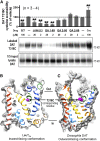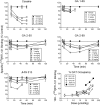Dopamine Transporter Dynamics of N-Substituted Benztropine Analogs with Atypical Behavioral Effects
- PMID: 29945932
- PMCID: PMC6102189
- DOI: 10.1124/jpet.118.250498
Dopamine Transporter Dynamics of N-Substituted Benztropine Analogs with Atypical Behavioral Effects
Abstract
Atypical dopamine transporter (DAT) inhibitors, despite high DAT affinity, do not produce the psychomotor stimulant and abuse profile of standard DAT inhibitors such as cocaine. Proposed contributing features for those differences include off-target actions, slow onsets of action, and ligand bias regarding DAT conformation. Several 3α-(4',4''-difluoro-diphenylmethoxy)tropanes were examined, including those with the following substitutions: N-(indole-3''-ethyl)- (GA1-69), N-(R)-2''-amino-3''-methyl-n-butyl- (GA2-50), N-2''aminoethyl- (GA2-99), and N-(cyclopropylmethyl)- (JHW013). These compounds were previously reported to have rapid onset of behavioral effects and were presently evaluated pharmacologically alone or in combination with cocaine. DAT conformational mode was assessed by substituted-cysteine accessibility and molecular dynamics (MD) simulations. As determined by substituted-cysteine alkylation, all BZT analogs except GA2-99 showed bias for a cytoplasmic-facing DAT conformation, whereas cocaine stabilized the extracellular-facing conformation. MD simulations suggested that several analog-DAT complexes formed stable R85-D476 "outer gate" bonds that close the DAT to extracellular space. GA2-99 diverged from this pattern, yet had effects similar to those of other atypical DAT inhibitors. Apparent DAT association rates of the BZT analogs in vivo were slower than that for cocaine. None of the compounds was self-administered or stimulated locomotion, and each blocked those effects of cocaine. The present findings provide more detail on ligand-induced DAT conformations and indicate that aspects of DAT conformation other than "open" versus "closed" may facilitate predictions of the actions of DAT inhibitors and may promote rational design of potential treatments for psychomotor-stimulant abuse.
U.S. Government work not protected by U.S. copyright.
Figures









Similar articles
-
Relations between stimulation of mesolimbic dopamine and place conditioning in rats produced by cocaine or drugs that are tolerant to dopamine transporter conformational change.Psychopharmacology (Berl). 2013 Sep;229(2):307-21. doi: 10.1007/s00213-013-3109-6. Epub 2013 Apr 24. Psychopharmacology (Berl). 2013. PMID: 23612854 Free PMC article.
-
Molecular dynamics of conformation-specific dopamine transporter-inhibitor complexes.J Mol Graph Model. 2017 Sep;76:143-151. doi: 10.1016/j.jmgm.2017.07.003. Epub 2017 Jul 11. J Mol Graph Model. 2017. PMID: 28734204 Free PMC article.
-
Applicability of the dopamine and rate hypotheses in explaining the differences in behavioral pharmacology of the chloro-benztropine analogs: studies conducted using intracerebral microdialysis and population pharmacodynamic modeling.J Pharmacol Exp Ther. 2007 Aug;322(2):760-9. doi: 10.1124/jpet.107.123315. Epub 2007 May 22. J Pharmacol Exp Ther. 2007. PMID: 17519385
-
Discovery of drugs to treat cocaine dependence: behavioral and neurochemical effects of atypical dopamine transport inhibitors.Adv Pharmacol. 2009;57:253-89. doi: 10.1016/S1054-3589(08)57007-4. Epub 2009 Nov 27. Adv Pharmacol. 2009. PMID: 20230764 Free PMC article. Review.
-
Behavioral, biological, and chemical perspectives on atypical agents targeting the dopamine transporter.Drug Alcohol Depend. 2015 Feb 1;147:1-19. doi: 10.1016/j.drugalcdep.2014.12.005. Epub 2014 Dec 18. Drug Alcohol Depend. 2015. PMID: 25548026 Free PMC article. Review.
Cited by
-
Functional Characterization of the Dopaminergic Psychostimulant Sydnocarb as an Allosteric Modulator of the Human Dopamine Transporter.Biomedicines. 2021 Jun 2;9(6):634. doi: 10.3390/biomedicines9060634. Biomedicines. 2021. PMID: 34199621 Free PMC article.
-
Molecular mechanisms of action of stimulant novel psychoactive substances that target the high-affinity transporter for dopamine.Neuronal Signal. 2021 Nov 17;5(4):NS20210006. doi: 10.1042/NS20210006. eCollection 2021 Dec. Neuronal Signal. 2021. PMID: 34888062 Free PMC article. Review.
-
Identification of a Novel Allosteric Modulator of the Human Dopamine Transporter.ACS Chem Neurosci. 2019 Aug 21;10(8):3718-3730. doi: 10.1021/acschemneuro.9b00262. Epub 2019 Jun 24. ACS Chem Neurosci. 2019. PMID: 31184115 Free PMC article.
-
Effects of benztropine analogs on delay discounting in rats.Psychopharmacology (Berl). 2020 Dec;237(12):3783-3794. doi: 10.1007/s00213-020-05655-0. Epub 2020 Sep 22. Psychopharmacology (Berl). 2020. PMID: 32964243 Free PMC article.
-
Preclinical Profile of CM699 as a Medication Candidate for Stimulant Use Disorder.ACS Chem Neurosci. 2025 Apr 16;16(8):1454-1468. doi: 10.1021/acschemneuro.4c00589. Epub 2025 Mar 25. ACS Chem Neurosci. 2025. PMID: 40132017 Free PMC article.
References
-
- Agoston GE, Wu JH, Izenwasser S, George C, Katz J, Kline RH, Newman AH. (1997) Novel N-substituted 3 α-[bis(4′-fluorophenyl)methoxy]tropane analogues: selective ligands for the dopamine transporter. J Med Chem 40:4329–4339. - PubMed
-
- Bergman J, Madras BK, Johnson SE, Spealman RD. (1989) Effects of cocaine and related drugs in nonhuman primates. III. Self-administration by squirrel monkeys. J Pharmacol Exp Ther 251:150–155. - PubMed
-
- Corwin RL, Woolverton WL, Schuster CR. (1990) Effects of cholecystokinin, d-amphetamine and fenfluramine in rats trained to discriminate 3 from 22 hr of food deprivation. J Pharmacol Exp Ther 253:720–728. - PubMed
Publication types
MeSH terms
Substances
Grants and funding
LinkOut - more resources
Full Text Sources
Other Literature Sources
Research Materials

